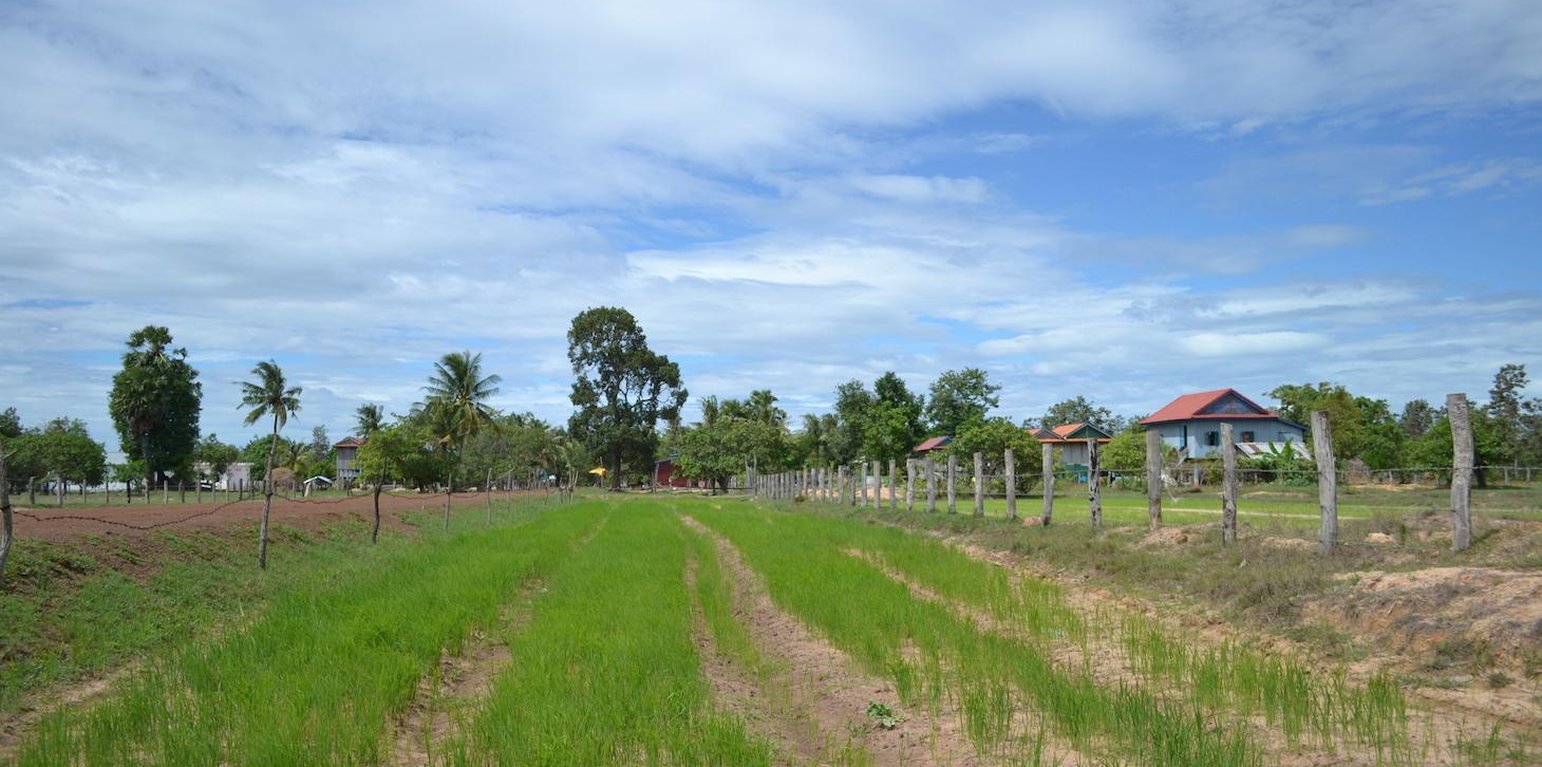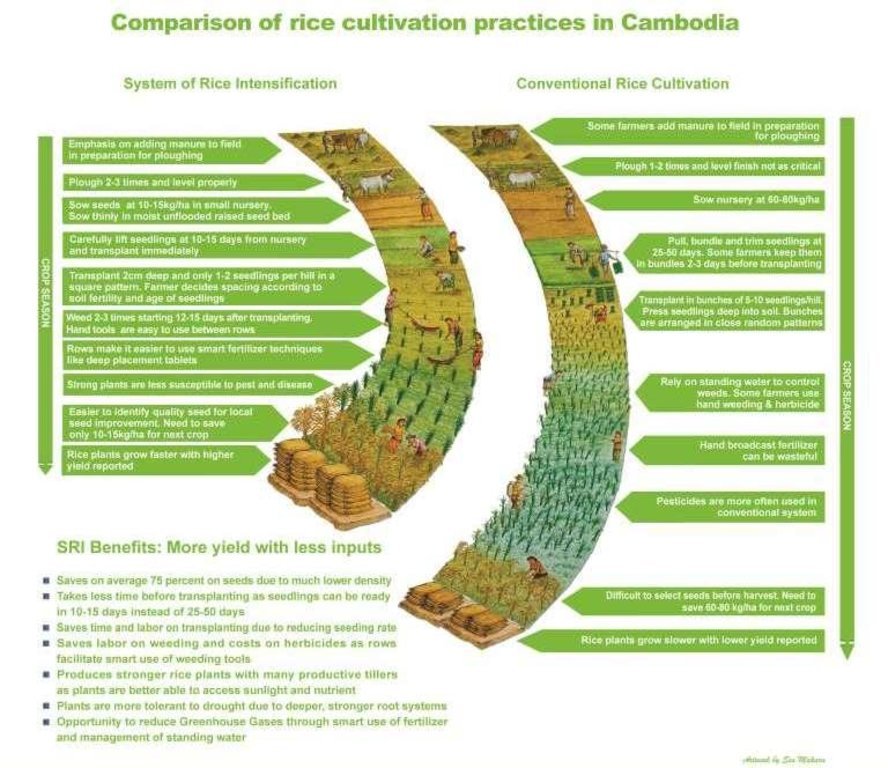



The System of Rice Intensification (SRI) was developed in the 1980s in Madagascar, where a French monk worked together with local farmers. The goals of the project were the improvement of the livelihoods of local farmers and the establishment of a farming system that is self-sufficient and thus needs no external inputs. SRI is not a recipe to be followed step by step, but general ideas that need to be adapted to the local conditions. These basic ideas are the following:
- Early transplanting of the seedlings, at the two-leaves-stage (less than 15 days after sowing). At this stage, the plant still has the potential to make a lot of tillers, and develop a strong root system. The seedlings are transplanted carefully, so the plant doesn’t suffer a transplanting shock.
- Wide spacing of single seedlings, usually in squares. The recommended spacing goes from 25 to 50 cm, depending on the soil fertility. This transplanting technique reduces the concurrence between the rice plants and allows the land user easier weeding.
- Aerating the soil. Rice is produced in standing water, but grows better if the roots are aerated. This is usually done with weeding, and additionally either by alternately flooding and letting the soil dry out, or by draining the water regularly. - The soil is fed with compost or manure in order to enhance the fertility and improve the soil structure.
SRI induces changes in deeply rooted local habits with some counter-intuitive knowledge like that more seeds do not produce more yields. Thus the methods have to be adapted locally and yields monitored to fit to other areas.
In Kampong Chhnang, the rice is transplanted at the six-leaves-stage, which is still earlier than conventional transplanting, with spacing of about 15 to 20 cm.
In Kampong Chhnang, the labour availability is low, as many young people work abroad or in the garment industry. Thus the SRI principles, which were taught by an NGO in 2004, were not followed completely, but adapted to this major constraint. The use of very young seedlings requires careful transplanting, which takes time. Thus the seedlings are transplanted at the 6 leaves stage. Due to the low soil fertility in the area, the optimal spacing as tested by CARDI (Cambodian Agricultural Research and Development Institute), was about 20 by 20 cm.
The rice seeds are soaked in water for 24 hours, and then let to germinate in a hot and humid place for two days. Then they are sown on the seed bed, which is prepared with compost. As there is not enough compost available for all the fields, the seedbed is the only place where compost is applied. In the fields chemical fertilizer is used. The seedlings are transplanted after 20 to 25 days (5-6 leaves) single or two per hill, in rows 15 to 20 cm apart. They are transplanted in better levelled fields than conventional transplanting, to allow the use of less water, as the seedlings are smaller than conventional. Otherwise the water management is the same as conventional; due to the lack of labour availability, the fields are not drained as proposed by the NGO 10 years ago. The field is weeded with hoes. The rice is harvested after 85 % of the panicle turned yellow, thus obtaining the best quality.
The analysed area is flat (slope < 2%), with a tropical climate (dry season from November to May and wet season from June to October), and the soils are mostly sandy or loamy. The soil has a low fertility, contains little organic matter, and acidifies. The area has been deforested a long time ago, and the groundwater table is rather high (1-2 m during the dry season, on the surface during wet season).
Due to climate change, farmers notice more erratic rainfalls, temperature rises and more recurrent droughts. Rice is the predominant crop grown in the area, since it serves as staple food (mix subsistence and commercial activities).
The increasing migration rate (the young generation leaves the villages to work in the cities, garment industry or abroad) results in a decrease of available labour force in the area which has detrimental effects on the agricultural activities. Furthermore, the civil war in the 1970s (Khmer Rouge) led to the loss of agricultural knowledge which different NGOs try to re-establish.
الموقع: Cher Kroev, Kampong Chhnang, كمبوديا
عدد مواقع تنفيذ التقنيةالتي تم تحليلها:
انتشار التقنية: منتشرة بالتساوي على مساحة (approx. 100-10 كم2)
في منطقة محمية بشكل دائم؟:
تاريخ التنفيذ: منذ 10-50 سنة
نوع التقديم




| تحديد المدخلات | الوحدة | الكمية | التكاليف لكل وحدة (غير متاح) | إجمالي التكاليف لكل مدخل (غير متاح) | % من التكاليف التي يتحملها مستخدمو الأراضي |
| معدات | |||||
| Compost house | 1,0 | 15,0 | 15,0 | 33,0 | |
| إجمالي تكاليف إنشاء التقنية | 15.0 | ||||
| إجمالي تكاليف إنشاء التقنية بالدولار الأمريكي | 15.0 | ||||
| تحديد المدخلات | الوحدة | الكمية | التكاليف لكل وحدة (غير متاح) | إجمالي التكاليف لكل مدخل (غير متاح) | % من التكاليف التي يتحملها مستخدمو الأراضي |
| العمالة | |||||
| labour | ha | 1,0 | 228,0 | 228,0 | 100,0 |
| معدات | |||||
| animal traction | ha | 1,0 | 56,0 | 56,0 | 100,0 |
| المواد النباتية | |||||
| seeds | ha | 1,0 | 15,0 | 15,0 | 100,0 |
| الأسمدة والمبيدات الحيوية | |||||
| fertilizer | ha | 1,0 | 55,0 | 55,0 | 100,0 |
| compost/manure | ha | 1,0 | 10,0 | 10,0 | 100,0 |
| إجمالي تكاليف صيانة التقنية | 364.0 | ||||
| إجمالي تكاليف صيانة التقنية بالدولار الأمريكي | 364.0 | ||||
Around 20% more yields
Seedbed can be irrigated
The seedbed is smaller, so less irrigation is needed in the beginning of the rainy season/dry spell
Used half the amount of seeds
Crop is more tolerant to droughts. He uses less chemical fertilizer since he uses compost
Knowledge about composting
SRI increased the rice yields and reduces the use of seeds.
Compost only used in seedbed